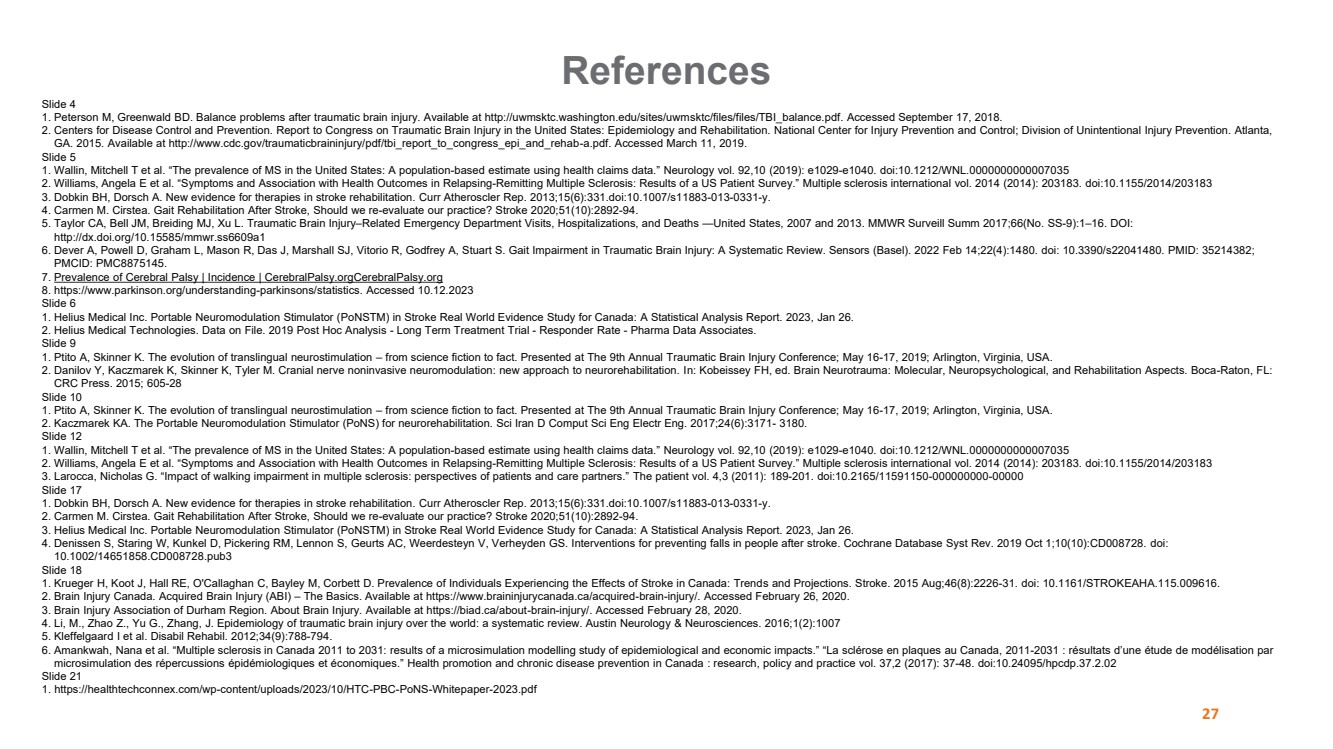
| References
27
Slide 4
1. Peterson M, Greenwald BD. Balance problems after traumatic brain injury. Available at http://uwmsktc.washington.edu/sites/uwmsktc/files/files/TBI_balance.pdf. Accessed September 17, 2018.
2. Centers for Disease Control and Prevention. Report to Congress on Traumatic Brain Injury in the United States: Epidemiology and Rehabilitation. National Center for Injury Prevention and Control; Division of Unintentional Injury Prevention. Atlanta,
GA. 2015. Available at http://www.cdc.gov/traumaticbraininjury/pdf/tbi_report_to_congress_epi_and_rehab-a.pdf. Accessed March 11, 2019.
Slide 5
1. Wallin, Mitchell T et al. “The prevalence of MS in the United States: A population-based estimate using health claims data.” Neurology vol. 92,10 (2019): e1029-e1040. doi:10.1212/WNL.0000000000007035
2. Williams, Angela E et al. “Symptoms and Association with Health Outcomes in Relapsing-Remitting Multiple Sclerosis: Results of a US Patient Survey.” Multiple sclerosis international vol. 2014 (2014): 203183. doi:10.1155/2014/203183
3. Dobkin BH, Dorsch A. New evidence for therapies in stroke rehabilitation. Curr Atheroscler Rep. 2013;15(6):331.doi:10.1007/s11883-013-0331-y.
4. Carmen M. Cirstea. Gait Rehabilitation After Stroke, Should we re-evaluate our practice? Stroke 2020;51(10):2892-94.
5. Taylor CA, Bell JM, Breiding MJ, Xu L. Traumatic Brain Injury–Related Emergency Department Visits, Hospitalizations, and Deaths —United States, 2007 and 2013. MMWR Surveill Summ 2017;66(No. SS-9):1–16. DOI:
http://dx.doi.org/10.15585/mmwr.ss6609a1
6. Dever A, Powell D, Graham L, Mason R, Das J, Marshall SJ, Vitorio R, Godfrey A, Stuart S. Gait Impairment in Traumatic Brain Injury: A Systematic Review. Sensors (Basel). 2022 Feb 14;22(4):1480. doi: 10.3390/s22041480. PMID: 35214382;
PMCID: PMC8875145.
7. Prevalence of Cerebral Palsy | Incidence | CerebralPalsy.orgCerebralPalsy.org
8. https://www.parkinson.org/understanding-parkinsons/statistics. Accessed 10.12.2023
Slide 6
1. Helius Medical Inc. Portable Neuromodulation Stimulator (PoNSTM) in Stroke Real World Evidence Study for Canada: A Statistical Analysis Report. 2023, Jan 26.
2. Helius Medical Technologies. Data on File. 2019 Post Hoc Analysis - Long Term Treatment Trial - Responder Rate - Pharma Data Associates.
Slide 9
1. Ptito A, Skinner K. The evolution of translingual neurostimulation – from science fiction to fact. Presented at The 9th Annual Traumatic Brain Injury Conference; May 16-17, 2019; Arlington, Virginia, USA.
2. Danilov Y, Kaczmarek K, Skinner K, Tyler M. Cranial nerve noninvasive neuromodulation: new approach to neurorehabilitation. In: Kobeissey FH, ed. Brain Neurotrauma: Molecular, Neuropsychological, and Rehabilitation Aspects. Boca-Raton, FL:
CRC Press. 2015; 605-28
Slide 10
1. Ptito A, Skinner K. The evolution of translingual neurostimulation – from science fiction to fact. Presented at The 9th Annual Traumatic Brain Injury Conference; May 16-17, 2019; Arlington, Virginia, USA.
2. Kaczmarek KA. The Portable Neuromodulation Stimulator (PoNS) for neurorehabilitation. Sci Iran D Comput Sci Eng Electr Eng. 2017;24(6):3171- 3180.
Slide 12
1. Wallin, Mitchell T et al. “The prevalence of MS in the United States: A population-based estimate using health claims data.” Neurology vol. 92,10 (2019): e1029-e1040. doi:10.1212/WNL.0000000000007035
2. Williams, Angela E et al. “Symptoms and Association with Health Outcomes in Relapsing-Remitting Multiple Sclerosis: Results of a US Patient Survey.” Multiple sclerosis international vol. 2014 (2014): 203183. doi:10.1155/2014/203183
3. Larocca, Nicholas G. “Impact of walking impairment in multiple sclerosis: perspectives of patients and care partners.” The patient vol. 4,3 (2011): 189-201. doi:10.2165/11591150-000000000-00000
Slide 17
1. Dobkin BH, Dorsch A. New evidence for therapies in stroke rehabilitation. Curr Atheroscler Rep. 2013;15(6):331.doi:10.1007/s11883-013-0331-y.
2. Carmen M. Cirstea. Gait Rehabilitation After Stroke, Should we re-evaluate our practice? Stroke 2020;51(10):2892-94.
3. Helius Medical Inc. Portable Neuromodulation Stimulator (PoNSTM) in Stroke Real World Evidence Study for Canada: A Statistical Analysis Report. 2023, Jan 26.
4. Denissen S, Staring W, Kunkel D, Pickering RM, Lennon S, Geurts AC, Weerdesteyn V, Verheyden GS. Interventions for preventing falls in people after stroke. Cochrane Database Syst Rev. 2019 Oct 1;10(10):CD008728. doi:
10.1002/14651858.CD008728.pub3
Slide 18
1. Krueger H, Koot J, Hall RE, O'Callaghan C, Bayley M, Corbett D. Prevalence of Individuals Experiencing the Effects of Stroke in Canada: Trends and Projections. Stroke. 2015 Aug;46(8):2226-31. doi: 10.1161/STROKEAHA.115.009616.
2. Brain Injury Canada. Acquired Brain Injury (ABI) – The Basics. Available at https://www.braininjurycanada.ca/acquired-brain-injury/. Accessed February 26, 2020.
3. Brain Injury Association of Durham Region. About Brain Injury. Available at https://biad.ca/about-brain-injury/. Accessed February 28, 2020.
4. Li, M., Zhao Z., Yu G., Zhang, J. Epidemiology of traumatic brain injury over the world: a systematic review. Austin Neurology & Neurosciences. 2016;1(2):1007
5. Kleffelgaard I et al. Disabil Rehabil. 2012;34(9):788-794.
6. Amankwah, Nana et al. “Multiple sclerosis in Canada 2011 to 2031: results of a microsimulation modelling study of epidemiological and economic impacts.” “La sclérose en plaques au Canada, 2011-2031 : résultats d’une étude de modélisation par
microsimulation des répercussions épidémiologiques et économiques.” Health promotion and chronic disease prevention in Canada : research, policy and practice vol. 37,2 (2017): 37-48. doi:10.24095/hpcdp.37.2.02
Slide 21
1. https://healthtechconnex.com/wp-content/uploads/2023/10/HTC-PBC-PoNS-Whitepaper-2023.pdf |